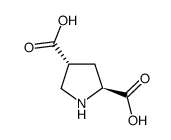Unexpected inhibitory regulation of glutamate release from rat cerebrocortical nerve terminals by presynaptic 5-hydroxytryptamine-2A receptors.
Su-Jane Wang, Kai-Yun Wang, Wei-Chieh Wang, Talvinder S Sihra
Index: J. Neurosci. Res. 84(7) , 1528-42, (2006)
Full Text: HTML
Abstract
Presynaptic 5-HT(2A) receptor modulation of glutamate release from rat cerebrocortical nerve terminals (synaptosomes) was investigated by using the 5-HT(2A/2C) receptor agonist (+/-)-1-[2,5-dimethoxy-4-iodophenyl]-2-aminopropane (DOI). DOI potently inhibited 4-aminopyridine (4AP)-evoked glutamate release. Involvement of presynaptic 5-HT(2A) receptors in this modulation of 4AP-evoked release was confirmed by blockade of the DOI-mediated inhibition by the 5-HT(2A) receptor antagonist ketanserin but not by the 5-HT(2C) receptor antagonist RS102221. Inhibition of glutamate release by DOI was associated with a reduction of 4AP-evoked depolarization and downstream elevation of cytoplasmic free calcium concentration ([Ca(2+)](C)) mediated via P/Q- and N-type voltage-dependent Ca(2+) channels (VDCCs). In contrast to the DOI effect on 4AP-evoked release, the agonist had no effect on high external [K(+)] (30 mM)-induced (KCl) stimulation of VDCCs or glutamate release. Likewise, release mediated by direct Ca(2+) entry with Ca(2+) ionophore (ionomycin) or by hypertonic sucrose was unaffected by DOI. Mechanistically, DOI modulation of 4AP-evoked glutamate release appeared to involve a phospholipase C/protein kinase C signaling cascade, insofar as pretreatment of synaptosomes with the phospholipase C inhibitor U73122 or protein kinase C inhibitors Ro320432 or GF109203X all effectively occluded the inhibitory effect of the agonist. Together, these results suggest that presynaptic 5-HT(2A) receptors present on glutamatergic terminals effect an unexpected depression of glutamate release by negatively modulating nerve terminal excitability and downstream VDCC activation through a signaling cascade involving phospholipase C/protein kinase C. These observations invoke presynaptic inhibitory 5-HT(2A) receptor function as a potential target for drugs to mitigate the effects of excessive glutamatergic transmission.
Related Compounds
| Structure | Name/CAS No. | Molecular Formula | Articles |
|---|---|---|---|
 |
trans-4-Carboxy-L-proline
CAS:64769-66-0 |
C6H9NO4 |
|
Evidence for a role of GABA- and glutamate-gated chloride ch...
2012-11-01 [Pharmacol. Biochem. Behav. 103(1) , 69-75, (2012)] |
|
Substituted pyrrolidine-2,4-dicarboxylic acid amides as pote...
2006-06-15 [Bioorg. Med. Chem. Lett. 16(12) , 3268-72, (2006)] |
|
The effects of local perfusion of DAMGO on extracellular GAB...
2008-02-01 [J. Neurochem. 104(3) , 806-17, (2008)] |
|
Effects of theanine, r-glutamylethylamide, on neurotransmitt...
2005-08-01 [Nutr. Neurosci. 8(4) , 219-26, (2005)] |
|
Dissociation between hippocampal neuronal loss, astroglial a...
2006-12-01 [Neurochem. Int. 49(7) , 691-7, (2006)] |